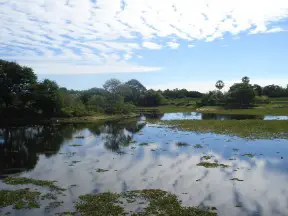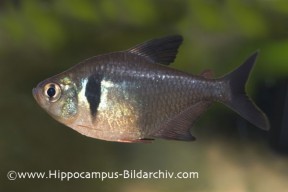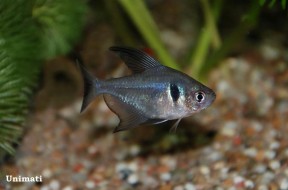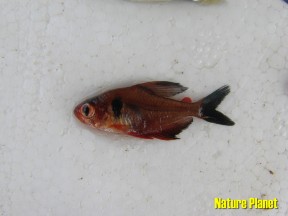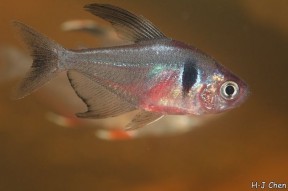Hyphessobrycon megalopterus
Black Phantom Tetra
SynonymsTop ↑
Megalamphodus megalopterus Eigenmann 1915; Megalamphodus rogoaguae Pearson, 1924
Etymology
Hyphessobrycon: from the Ancient Greek υπελάσσων (hyphésson), meaning ‘of lesser stature’, used as a prefix in this case, plus the generic name Brycon.
megalopterus: from the Ancient Greek μέγας (mégas), meaning ‘large, exaggerated’, and πτερόν (pterón), meaning ‘fin’, presumably in reference to the enlarged dorsal-fin in male individuals.
Classification
Order: Characiformes Family: Characidae
Distribution
Native to the upper rio Madeira, a major branch of the western Amazon watershed in Bolivia and western Brazil, including its major tributaries the rios Beni and Mamoré, plus the upper rio Paraguai in Brazil.
The majority of records pertain to the rio Guaporé (Río Iténez in Bolivia), the main affluent of the rio Mamoré, which drains the vast tropical wetland known as the Pantanal, and the upper rio Paraguai, which also has its headwaters in the Pantanal but flows in the opposite direction. The Guaporé and Paraguai are connected due to rising water levels during the annual wet season.
Type locality is ‘Cáceres, Mato Grosso, Brazil’, which has been considered an error (e.g. Weitzman & Palmer, 1997) but appears correct based on recent records (e.g. Britski et al., 2007; Polaz et al., 2014).
Habitat
Typically inhabits still and sluggish tributaries and backwaters, including ponds and small lakes, where it forms aggregations around patches of marginal vegetation or submerged tree roots.
In the Pantanal small characids are often found in extremely clear water where submerged vegetation proliferates. The wetland is rich in aquatic macrophytes with at least 280 species recorded, including members of genera popular in the aquarium hobby such as Echinodorus, Bacopa, Ludwigia, Sagittaria, Eleocharis, and Salvinia.
Maximum Standard Length
30 – 36 mm.
Aquarium SizeTop ↑
An aquarium with base dimensions of 80 ∗ 30 cm or equivalent should be the smallest considered.
Maintenance
Perhaps looks best in an arrangement comprising a sandy substrate plus some driftwood roots and branches, or heavily-planted planted set-up.
The addition of dried leaf litter would further emphasise the natural feel and as well as offering additional cover for the fish brings with it the growth of microbe colonies as decomposition occurs.
The latter are useful since they provide an additional food source for both adults and fry while the humic substances released by decaying leaves are also considered beneficial.
Water Conditions
Temperature: 20 – 28 °C
pH: 5.0 – 7.0
Hardness: 18 – 215 ppm
Diet
Likely to be omnivorous feeding on small invertebrates, crustacea, filamentous algae, fallen fruit and suchlike in nature.
In aquaria it may survive on a diet of dried foods but like most fishes does best when offered a varied menu which in this case should also contain live and frozen chironomid larvae (bloodworm), mosquito larvae, Daphnia, Moina, etc.
Behaviour and CompatibilityTop ↑
Very peaceful making it an ideal resident of the well-researched community aquarium.
It is perhaps best-maintained alongside similarly-sized characids, gasteropelecids, lebiasinids, smaller callichthyid or loricariid catfishes and non-predatory, small-to-medium-sized cichlids.
Try to buy a mixed-sex group of at least 8-10 specimens since this species forms temporary dominance hierarchies within which males compete for female attention, and therefore displays more interesting behaviour and better colouration when maintained in numbers.
Sexual Dimorphism
Adult males possess black fins of which the pelvic, dorsal, and anal are enlarged, while females are deeper-bodied and tend to have reddish pelvic, anal, and adipose fins.
Reproduction
An egg-scattering free spawner exhibiting no parental care.
When in good condition adults will spawn often and in a mature aquarium it is possible that small numbers of fry may start to appear without intervention, but if you want to maximise yield a more controlled approach is required.
The adult group can still be conditioned together but a smaller aquarium should also be set up and filled with mature water. This should be very dimly lit and the base covered with some kind of mesh of a large enough grade so that the eggs can fall through but small enough so that the adults cannot reach them. The widely available plastic ‘grass’-type matting can also be used and works well, as does a layer of glass marbles. Alternatively, filling much of the tank with a fine-leaved plant such as Taxiphyllum spp. or spawning mops can also return decent results.
The water itself should be of slightly acidic to neutral pH with a temperature towards the upper end of the range suggested above. An air-powered sponge filter or air stone(s) should also be included to provide oxygenation and water movement.
When the adult fish are well-conditioned a single pair or group comprising one or two males and several females can then be introduced to each container and left in place until eggs are detected (typically the following morning).
Initial food should be Paramecium or a proprietary dry food of sufficiently small (5-50 micron) grade, introducing Artemia nauplii, microworm, etc., once the fry are large enough to accept them.
NotesTop ↑
This species is popular in the aquarium hobby and is bred on a commercial basis in several countries. An ornamental ‘long-finned’ strain is sometimes available.
Following the most recent diagnosis by Géry (1977), it can be distinguished from congeners by the following combination of characters: postorbital bones very weak or absent; 10-20 maxillary teeth; humeral spot large; dorsal and anal fins dark; enlarged pelvic, dorsal, and anal fins in adults.
H. megalopterus was originally described as type species of the genus Megalamphodus Eigenmann 1915, which was diagnosed by possession of only a single row of teeth. This was synonymised with Hyphessobrycon by Weitzman and Palmer (1997) who found that some individuals of M. megalopterus and the related M. micropterus possessed two rows of teeth as in some members of their ‘rosy tetra’ group (see below). In addition, most of the species formerly included in Megalamphodus display other characters associated with this putative assemblage, most obviously a dark marking in the dorsal-fin and a dark humeral spot.
Hyphessobrycon was raised by Durbin in Eigenmann (1908) as a subgenus of Hemigrammus, differing from the latter by the absence of scales on the caudal-fin.
The grouping was revised by Eigenmann (1918, 1921) while Géry (1977) created artificial groups of species based on colour pattern, and these definitions are still widely used today, e.g., the H. agulha group, the H. heterohabdus group, etc. These cannot be considered to represent monophyletic assemblages, however, and their concepts continue to be redefined.
Weitzman & Palmer (1997) hypothesised the existence of a monophyletic assemblage within the genus based on colour pattern and male fin morphology that they termed the ‘rosy tetra clade’, with one of the characters supporting its monophyly being presence of a prominent dark marking on the dorsal-fin. This assemblage, plus other morphologically similar species, is considered to represent Hyphessobrycon sensu stricto by some authors, with the remaining species included in a much-expanded H. heterohabdus group.
Others have proposed conflicting, typically more restricted, views of both the genus and/or its constituent species groups, and significant confusion remains. What is clear is that, as currently recognised, Hyphessobrycon is a polyphyletic lineage containing several genera.
The process of splitting it up has already started, and Malabarba et al. (2012) revalidated the genus Ectrepopterus Fowler, previously considered a synonym of Hyphessobrycon. They also analysed its relationships within the Characidae in the context of Mirande’s (2010) previous work, but included the type species, H. compressus, for the first time in such a study. The results demonstrated that H. compressus is more closely-related to ‘rosy tetra’ representatives such as H. eques, H. pulchripinnis, and H. socolofi than other members of the genus including H. anisitsi, H. bifasciatus, H. elachys, H. herbertaxelrodi, and H. luetkeni.
References
- Eigenmann, C. H., 1915 - Memoirs of the Carnegie Museum 7(1): 1-99
The Cheirodontinae, a subfamily of minute characid fishes of South America. - Britski, H. A., K. Z. D. S. Silimon, and B. S. Lopes, 2007 - Brasília, DF: Embrapa Informaçäo Tecnológica: 1-227
Peixes do Pantanal: manual de identificaçäo, 2 ed. - Calcagnotto, D., S. A. Schaefer, and R. DeSalle, 2005 - Molecular Phylogenetics and Evolution 36(1): 135-153
Relationships among characiform fishes inferred from analysis of nuclear and mitochondrial gene sequences. - Géry, J., 1977 - T. F. H. Publications, Inc.: 1-672
Characoids of the world. - Lasso, C. A., V. Castelló, T. Canales-Tilve and J. Cabot-Nieves, 2001 - Memoria de la Fundación La Salle de Ciencias Naturales 59(152): 89-103
Contribución al conocimiento de la ictiofauna del Río Paraguá, cuenca del Río Itenzen o Guaporé, Amazonía Boliviana. - Malabarba, L. R., V. A. Bertaco, F. R. Carvalho & T. O. Litz., 2012 - Zootaxa 3204: 47-60
Revalidation of the genus Ectrepopterus Fowler (Teleostei: Characiformes), with the redescription of its type species, E. uruguayensis. - Mirande, J. M., 2010 - Neotropical Ichthyology 8(3): 385-568
Phylogeny of the family Characidae (Teleostei: Characiformes): from characters to taxonomy. - Oliveira, C. A., G. S. Avellino, K. T. Abe, T. C. Mariguela, R. C. Benine, G. Orti, R. P. Vari, and R. M. Corrêa e Castro, 2011 - BMC Evolutionary Biology 11(1): 275-300
Phylogenetic relationships within the speciose family Characidae (Teleostei: Ostariophysi: Characiformes) based on multilocus analysis and extensive ingroup sampling. - Polaz C. N. M., B. F. Melo, R. Britzke, E. K. de Resende, F. de Arruda Machado, J. A. F. de Lima, and M. Petrere Jr., 2014 - Check List 10(1): 122-130
Fishes from the Parque Nacional do Pantanal Matogrossense, upper Paraguai River basin, Brazil. - Por, F. D., 1995 - Springer Netherlands: 65-71
Ichthyofauna. In: The Pantanal of Mato Grosso (Brazil) - Pott, V. J., A. Pott, L. C. P. Lima, S. N. Moreira, and A. K. M. Oliveira, 2011 - Brazilian Journal of Biology 71(1): 255-263
Aquatic macrophyte diversity of the Pantanal wetland and upper basin. - Reis, R. E., S. O. Kullander and C. J. Ferraris, Jr. (eds), 2003 - EDIPUCRS, Porto Alegre: i-xi + 1-729
Check list of the freshwater fishes of South and Central America. CLOFFSCA. - Riehl, R. and H.A. Baensch, 1991 - Melle: Mergus, Verlag für Natur-und Heimtierkunde, Germany: 1-992
Aquarium Atlas. Volume 1. - Weitzman, S. H. and L. Palmer, 1997 - Ichthyological Exploration of Freshwaters 7(3): 209-242
A new species of Hyphessobrycon (Teleostei: Characidae) from the Neblina region of Venezuela and Brazil, with comments on the putative `rosy tetra clade'. - Zarske, A., 2014 - Vertebrate Zoology 64(2): 139-167
Zur Systematik einiger Blutsalmler oder "Rosy Tetras" (Teleostei: Ostariophysi: Characidae).

